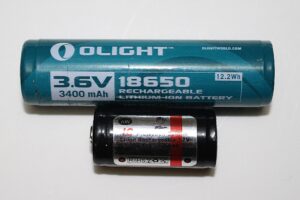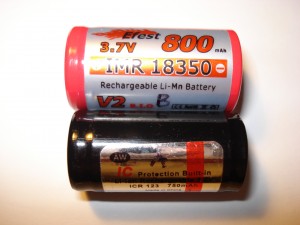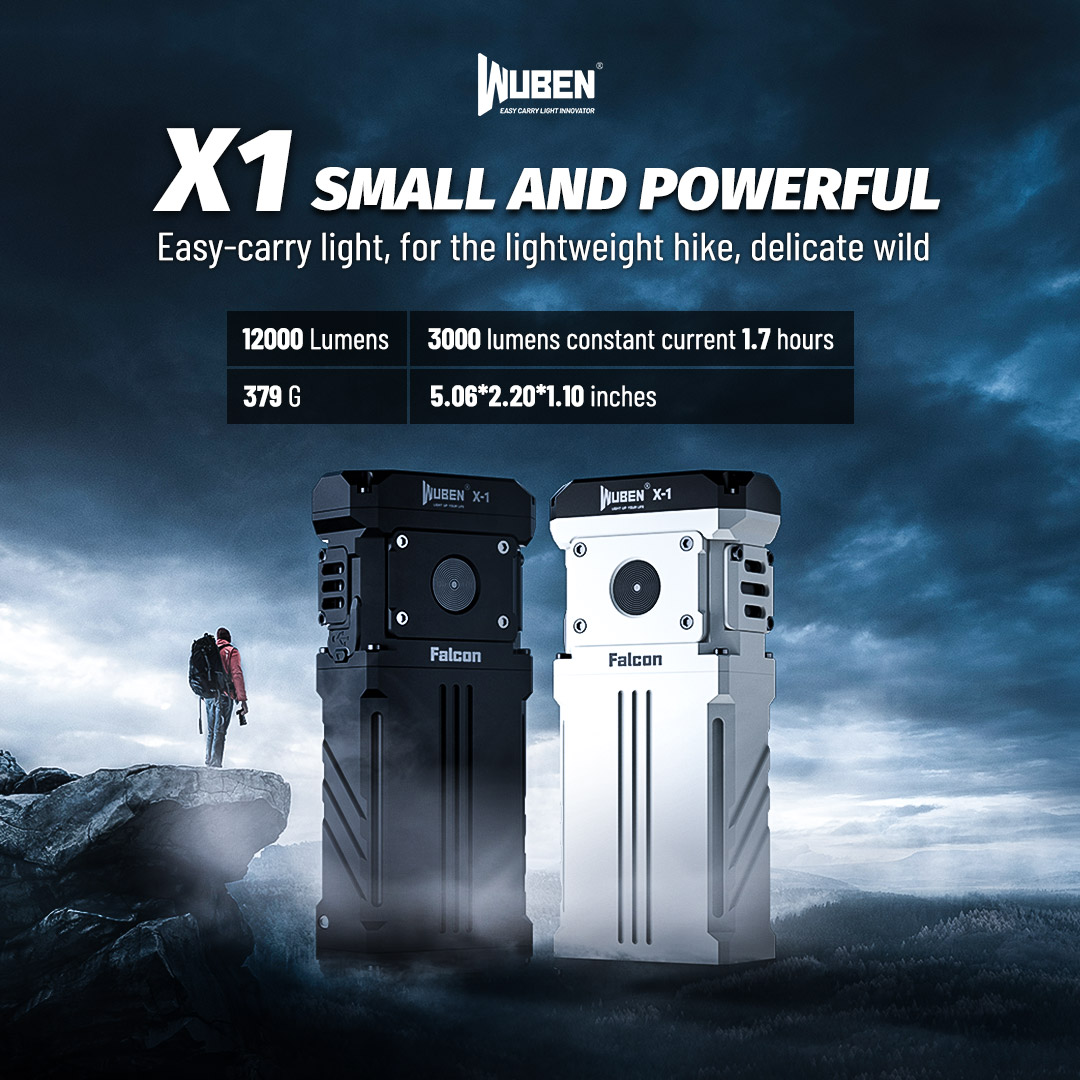Batteries are an excellent source of portable power, and are literally everywhere. Since the invention of Lithium-ion batteries in the 1970’s, their overall usefulness has grown leaps and bounds! Their ability to provide a higher current, plus being able to store higher amounts of energy, makes them very desirable for energy hungry applications. But, like with everything, there are downsides. In this post, I’ll discuss them from all angles.
Shapes and sizes

(top) 18650 (bottom) 16340
Just like people, lithium batteries share differences from each other. Your cell phone uses the flat, square variety. Most digital cameras use them too.
Other devices find these batteries useful as well, including power tools, electric shavers, laptops and a massive variety of LED flashlights.
If you’re wondering why lithium batteries have strange numerical names, it’s because of their size. For instance, a 16340 cell is 16mm x 34mm. The zero at the end refers to its cylindrical shape. From that, it shouldn’t be too hard to imagine why a 18650 is so-named.
Aside from a camera, about the only device where a consumer actually “handles” the cell, or needs to charge it manually, is the LED flashlight. More on that handling process in a bit.
Be Informed Before You Buy (Capacities Can Lie)
This section is devoted to advertised capacities of lithium batteries, which varies widely.
The word “capacity” refers to the amount of energy the battery is capable of holding. A smaller capacity means a shorter “runtime”. Larger capacities indicate the battery will run for a much longer period of time between charges.
With a 18650, most of what you see advertised is pretty accurate. The smallest capacity is around 2200 mAh. These days a 18650 can deliver up to 3500 mAh quite comfortably.
Where listed vs. “actual” capacities can vary, is often with a 16340 or a 14500. With these batteries, the most power you’ll usually get is 750 mAh. Some are less than 750. Many Chinese marketers will often attempt to falsely raise the claims on these particular cells. Some might be sold as 800 mAh and some are sold as 900 mAh.
I can tell you from experience, that I bought four 16340’s a few years back, at 900 mAh each. They are the poorest performing of all the batteries I own! They discharge very quickly, and won’t charge much above 4.10 volts. One thing IS for sure, if (or when) you see any 14500, or 16340 cells with an advertised capacity as high as 1000 mAh…don’t believe it. This is pure hype, and not only that, the batteries won’t perform any better than those labeled as 750 or 800 mAh. There’s also the possibility that their actual capacity is much LESS than 750 mAh!!
The WORST offender of all, with regards to faked cell capacity, is the 18650!
Good quality 18650’s can be found at this link!
Advantages of Lithium-ion

IMR 18350 and a protected ICR 16340
- No “memory effect”. This means that they’re not bound by any particular charging rituals, meaning they can be charged more frequently without the cell always depleting at the same interval.
- Very powerful
- Can be recharged hundreds of times
- Very low self-discharge rate
- Not affected by cold temperatures
Are There Any Disadvantages?
Yes. As with ANY battery – eventually they’ll wear out.
To explain further, the charging cycles leave internal deposits, which over time diminish its effectiveness and its ability to hold a full charge. This DOES however take a LONG time to have any effect.
Are Lithium Batteries Dangerous in Any Way?
Yes. BUT, ONLY in specific situations.
You would certainly not want to pair mismatched batteries in the same device. And that goes the same for ANY type of battery. You must also be careful you’re not using them in pairs, where the starting voltage of each one is significantly different. Each battery must be relatively close in voltage. In order to do all this correctly you’ll need a good quality charger and/or multimeter.
Other precautions include – to never over charge or over DIS-charge a lithium cell. Buying “protected” cells will take this worry out of your hands. This means that the battery will effectively shut down when the voltage gets too low. The protection circuit will also keep it from over charging. Just look for the term “protected” when purchasing Lithium-ion batteries.
Please be sure to click the link I put in an earlier paragraph, with regards to “fake” batteries! That is one of the biggest dangers by far!
As long as you know what you’re doing, and are using them in good quality equipment, you CAN use UNprotected lithium batteries…which are useful in high-drain devices such as flashlights. Most “IMR” lithium batteries are unprotected.
For a superb selction of Lithium-ion batteries, click here!






I bought a bunch of “1,800” mah 16340 batteries a few years ago and have felt ripped off! I wish that I read this. At least I’m in “the know” now and will research them before I buy stupid crap! Thanks!
Thanks David. I’m glad this was of help!
I have been told to leave my scooter lithium battery on permanent charge.
use the scooter for weekly supermarket shopping and an odd day visiting local.
I have checked advise sites & cannot see if this right
I won’t pretend to know much about the types of batteries scooters use, but I’m sure there must be many scooter forums where technical people hang out.
Depending on the device, and the method of manufacture, lithium batteries can be tricky. As long as the scooter can hold a charge when not in use, I would definitely not recommend a “constant” charge.